A Study on the Influence of the Properties of Commercial Soft Magnetic Composite Somaloy Materials on the Compaction Process
Abstract
1. Introduction
- To evaluate the material properties of commercial SMC powders under various thermal and mechanical processing conditions.
- To determine the optimal forming parameters using a full factorial experimental design and to quantitatively analyze compaction behavior through finite element analysis (FEA).
- To fabricate toroidal core specimens under optimal conditions and compare experimental results with simulations.
- To validate the analysis through density measurements and high-resolution microstructural characterization of the fabricated specimens.
- To assess the process suitability of commercial SMC powders and propose a practical process design guide for the development of high-reliability motor cores.
2. Materials and Methods
2.1. Evaluation of Basic Properties of Somaloy Powders for Compaction Analysis
2.1.1. Evaluation of the Compaction Behavior of Somaloy Powders
2.1.2. Analysis of Thermal Properties Applicable to Compaction Simulation
2.1.3. Identification of the Crystalline Phases of the Powders
2.1.4. Analysis of Particle Morphology and Size Distribution
2.2. Experiment Methods
2.2.1. Insulation Properties of the Powder
2.2.2. Yield Criterion and Model Selection of Porous SMCs
2.2.3. Full Factorial Experiment Design
3. Powder Compaction Simulation
3.1. Simulation Setup
3.2. Simulation Result
4. Experimental Validation
4.1. Toroidal Core Fabrication
4.1.1. Comparison of Press and Simulation Load–Stroke Behavior
4.1.2. Density Analysis
4.2. Microstructural Properties of Toroidal Core
4.2.1. Bulk Microstructure Analysis of Somaloy
4.2.2. Bulk Morphology Analysis of Somaloy
4.2.3. Crystal Structures of Bulk Specimen
4.2.4. Electromagnetic Characteristics Inferred from Microstructural Differences
5. Conclusions
Author Contributions
Funding
Institutional Review Board Statement
Informed Consent Statement
Data Availability Statement
Conflicts of Interest
References
- Guo, Y.; Ba, X.; Liu, L.; Lu, H.; Lei, G.; Yin, W.; Zhu, J. A Review of Electric Motors with Soft Magnetic Composite Cores for Electric Drives. Energies 2023, 16, 2053. [Google Scholar] [CrossRef]
- Lutsey, N. Global Climate Change Mitigation Potential from a Transition to Electric Vehicles; The International Council on Clean Transportation: Washington, DC, USA, 2015; Report No. 2015.5; p. 5. [Google Scholar]
- European Commission. Mobility Strategy-European Commission-Mobility and Transport; European Commission: Brussels, Belgium, 2021. [Google Scholar]
- Credo, A.; Tursini, M.; Villani, M.; Di Lodovico, C.; Orlando, M.; Frattari, F. Axial Flux PM In-Wheel Motor for Electric Vehicles: 3D Multiphysics Analysis. Energies 2021, 14, 2107. [Google Scholar] [CrossRef]
- Sandia National Laboratories. Electric Drive Technologies Research: Bottom-Up Soft Magnetic Composites (FY2022 Annual Progress Report); Sandia National Laboratories: Albuquerque, MN, USA, 2022.
- Bitsi, K.; Kowal, D.; Moghaddam, R.R. 3-D FEM Investigation of Eddy Current Losses in Rotor Lamination Steel Sheets. In Proceedings of the 2018 XIII International Conference on Electrical Machines (ICEM), Alexandroupoli, Greece, 25 October 2018; pp. 1832–1837. [Google Scholar]
- Kurtuluş, F.; Akboy, E. Axial Flux Permanent Magnet Motor Design for Lightweight Unmanned Aerial Vehicles. Turk. J. Electr. Power Energy Syst. 2025, 5, 2–9. [Google Scholar] [CrossRef]
- Wang, J.; Liu, X.; Zheng, Z.; Qiu, Z.; Li, K.; Xu, J.; Zeng, D. Reduction of Core Loss for FeSi Soft Magnetic Composites Prepared Using Atomic Layer Deposition-Based Coating and High-Temperature Annealing. J. Alloys Compd. 2022, 925, 169521. [Google Scholar] [CrossRef]
- Sumitomo Electric. Soft Magnetic Powder Core|Sumitomo Electric; Sumitomo Electric: Osaka, Japan, 2021. [Google Scholar]
- Shen, X.; Huang, S.; He, Y.; Liogas, K.A.; Lau, K.B.; Wang, P.; Lee, C.H. Evaluation of Microstructure, Mechanical and Magnetic Properties of Laser Powder Bed Fused Fe-Si Alloy for 3D Magnetic Flux Motor Application. Mater. Sci. Eng. A 2023, 864, 144589. [Google Scholar] [CrossRef]
- Bureš, R.; Fáberová, M.; Birčáková, Z. High-Pressure Compaction of Soft Magnetic Iron Powder. Powder Technol. 2023, 421, 118434. [Google Scholar] [CrossRef]
- Wu, F.; Liu, Z.; Dong, Y.; Zhang, R.; He, A.; Ling, Y.; Liu, X. Correlation Mechanism of Microstructure, Magnetic Domain, and Magnetic Softness of Fe-6.5 wt.% Si Composites with High Saturation. J. Supercond. Nov. Magn. 2023, 36, 733–743. [Google Scholar] [CrossRef]
- Pošković, E.; Franchini, F.; Ferraris, L.; Fracchia, E.; Bidulska, J.; Carosio, F.; Bidulsky, R.; Actis Grande, M. Recent Advances in Multi-Functional Coatings for Soft Magnetic Composites: A Review. Materials 2021, 14, 6844. [Google Scholar] [CrossRef]
- Bures, R.; Milyutin, V.A.; Faberova, M.; Bircakova, Z.; Kollar, P.; Fuzer, J. The First Experimentally Obtained Dataset on Processing Parameters and Functional Properties of Soft Magnetic Composites. Sci. Data 2025, 12, 8. [Google Scholar] [CrossRef]
- Evangelista, L.L.; Oliveira, A.C.; Santos, J.M.; Klein, A.N. Novel Soft Magnetic Composite with Insulating Layers Formed In Situ from Hydrothermal Carbon Nanospheres and Boric Acid. J. Alloys Compd. 2023, 942, 169013. [Google Scholar] [CrossRef]
- Zhang, H.; Zhu, X.; Zhang, X.B.; Liu, W.; Su, H.; Zou, Z.; Wang, J. Great Reduction in Pressing Pressure by Particle Grading for Fe-Si-Al Soft Magnetic Powder Cores with Good Low-Frequency Magnetic Properties. J. Magn. Magn. Mater. 2022, 555, 169325. [Google Scholar] [CrossRef]
- Kang, S.; Lee, S. Application of Soft Magnetic Composite in XEV Motor Core Manufacturing: Process Effects and Performance Analysis. Metals 2024, 14, 1163. [Google Scholar] [CrossRef]
- Höganäs AB. Soft Magnetic Composites–Technical Data Sheets; Höganäs AB: Höganäs, Sweden, 2021; Available online: https://www.hoganas.com (accessed on 1 August 2025).
- Asari, A.R.; Guo, Y.; Zhu, Z. Performances of SOMALOY 700 (5P) and SOMALOY 500 Materials under One-Dimensional Alternating Magnetic Flux Density. J. Magn. Magn. Mater. 2020, 513, 167121. [Google Scholar]
- Siesing, L.; Frogner, K.; Jeppsson, P.; Cedell, T.; Andersson, M. Soft Magnetic Moldable Composites: Properties and Applications. J. Magn. Magn. Mater. 2012, 324, 2717–2722. [Google Scholar] [CrossRef]
- Li, J.W.; An, X.Z. Double-Action Die Compaction of Fe-Al Composite Powder—A Study by MPFEM Simulation. In Proceedings of the 3rd Annual International Conference on Advanced Material Engineering (AME 2017), Shanghai, China, 14–16 April 2017; Atlantis Press: Amsterdam, The Netherlands, 2017; pp. 119–128. [Google Scholar]
- Lebhard, A. Evaluation of an SMC Powder During Uniaxial Compaction and Subsequent Annealing Treatment. Diploma Thesis, Technische Universität Wien, Vienna, Austria, 2021. [Google Scholar]
- ASTM E209; Standard Practice for Compression Tests of Metallic Materials at Elevated Temperatures with Conventional or Rapid Heating Rates and Strain Rates. ASTM: West Conshohocken, PA, USA, 2017.
- Kang, S.; Lee, S. A Study on the Optimal Powder Metallurgy Process to Obtain Suitable Material Properties of Soft Magnetic Composite Materials for Electric Vehicles. Metals 2024, 14, 815. [Google Scholar] [CrossRef]
- Höganäs AB. Somaloy® 5P–Material Data. In Technical Data Sheet; Höganäs AB: Höganäs, Sweden, 2024. [Google Scholar]
- Kang, S.; Lee, S. Optimizing the Manufacturing Process Control of Si-Based Soft Magnetic Composites. Materials 2025, 18, 2321. [Google Scholar] [CrossRef]
- Giannotta, N. Design and Characterization of New Soft Magnetic Composites for Electromagnetic Applications. Ph.D. Thesis, University of Modena and Reggio Emilia, Modena, Italy, 2023. [Google Scholar]
- ISO 22007-2:2015; Plastics—Determination of Thermal Conductivity and Thermal Diffusivity—Part 2: Transient Plane Heat Source (Hot Disc) Method. International Organization for Standardization (ISO): Geneva, Switzerland, 2015.
- ASTM E228-17; Standard Test Method for Linear Thermal Expansion of Solid Materials with a Push-Rod Dilatometer. ASTM International: West Conshohocken, PA, USA, 2017.
- Wan, L.; Sun, X.; Li, J.; Wu, S. Preparation and Magnetic Properties of Low-Loss Soft Magnetic Composites Using MgO-Phenolic Resin Coating. Materials 2024, 17, 4039. [Google Scholar] [CrossRef]
- Wang, L.; Chen, H.; Zhang, Y.; Liu, X.; Wang, J. Fabrication of High-Performance FeSiCr-Based Soft Magnetic Composites with Enhanced High-Frequency Properties. J. Mater. Res. Technol. 2024, 33, 1821–1832. [Google Scholar]
- Qiu, Y.; Wang, R.; He, Y.; Kong, H.; Li, S.; Wu, Z. Effects of Axial Pressure on the Evolution of Core–Shell Heterogeneous Structures and Magnetic Properties of Fe–Si Soft Magnetic Powder Cores during Hot-Press Sintering. RSC Adv. 2022, 12, 19875–19884. [Google Scholar] [CrossRef]
- Lin, D.; Park, J.-S.; Kim, S.-W.; Lee, H.-J. Experimental and Simulation Analysis of Hot Isostatic Pressing of Gas Atomized Stainless Steel 316L Powder Compacts. Korean J. Met. Mater. 2016, 54, 732–742. [Google Scholar] [CrossRef]
- He, Y.; Li, G.; Yang, S.; Tian, M.; Xu, J.; Demidenko, O.; Wu, Z.; Liu, X.; Wang, J. Improvements of Magnetic Performances for Carbonyl Iron Soft Magnetic Composites (CI-SMCs) Induced by Mn-Based Phosphating Coating. J. Alloys Compd. 2023, 733, 170498. [Google Scholar] [CrossRef]
- Ataullah, H.; Iqbal, T.; Khalil, I.U.; Mohammad, A.-S.; Ullah, N.; Farrag, M.E. Analysis and Verification of Leakage Inductance Calculation in DAB Converters Based on High-Frequency Toroidal Transformers under Different Design Scenarios. Energies 2022, 15, 6176. [Google Scholar] [CrossRef]
- Kim, W.-Y.; Matsumoto, R.; Utsunomiya, H. Prediction of Deformation Behavior of Metallic Foams Using a Yield Criterion for Compressible Materials. Mater. Trans. 2018, 59, 1892–1897. [Google Scholar] [CrossRef]
- Demir, U.; Kocabıçak, Z.K. Performance Assessments of the Material for the Traction Motor Cores of an Electric Racing Kart. Mater. Test. 2021, 63, 519–528. [Google Scholar] [CrossRef]
- Das, S.; Das, S.; Das, K. Use of Two-Level Full Factorial Design for Evaluating the Influence of Milling Time and Sintering Temperature on Densification of Al–Y2W3O12–AlN Hybrid Composites. Materials 2021, 14, 85. [Google Scholar]
- Arifin, M.; Abdalla, M.; Mamat, M. Full Factorial Experimental Design for Optimizing Spark Plasma Sintering Parameters of Fe–Si Soft Magnetic Composites. Materials 2022, 15, 1956. [Google Scholar]
- Li, J.; An, X.Z.; Cheng, T.; Zhao, P.; Zhang, Y. Analysis of Powder Compaction Process Using Multi-Particle Finite Element Method. Mater. Trans. 2022, 63, 1576–1582. [Google Scholar] [CrossRef]
- Ghorbani-Menghari, H.; Karami, H.; Ziarani, M.R.; Saeidi, S. Optimizing Powder Compaction for Enhanced Relative Density: Insights from Multi-Particle Finite Element Simulations and Genetic Algorithm. Mater. Res. Proc. 2024, 41, 2554–2561. [Google Scholar] [CrossRef]
- Stewart, S.; Jones, T.; Patel, K.; Martin, P. Experimentally Validated DEM for Large-Deformation Powder Compaction. EngRxiv Preprint 2025. [Google Scholar] [CrossRef]
- Hafiz, M.A.; Nor, N.H.M.; Shawal, S.Z.M.; Rahman, M.M. Modelling and Simulation of Stainless-Steel Powder during Compaction Process. J. Kejurut. 2025, 37, 959–965. [Google Scholar]
- Besson, P.; Thibaut, J.-L.; Dubois, J.; Marchand, M.; Aubry, C. Investigation of the Compaction Process of Electrical-Machine Magnetic Circuits and Its Detrimental Effect on Magnetic Performances. Sci. Rep. 2022, 12, 18983. [Google Scholar]
- Ding, W.; Jiang, L.; Xiu, Z.; Ma, K.; Yang, W.; Wu, G. Theoretical Relationship among Electrical Resistivity, Insulator Volume Content and Powder Coating Rate of Soft Magnetic Composite. Optoelectron. Adv. Mater. Rapid Commun. 2013, 7, 466–469. [Google Scholar]
- Pošković, E.; Franchini, F.; Ferraris, L. Effect of the Insulating Layer on the Properties of SMC Inductors. Appl. Sci. 2022, 12, 8756. [Google Scholar] [CrossRef]
- Zhao, Q.; Li, X.; Chen, Y.; Wang, H.; Liu, J.; Zhang, P. Ultra-Low Core Loss and High-Frequency Permeability Stability in Hot-Press Sintered FeSi Soft Magnetic Composites by Fe2O3 Nanoparticles Air Gap Filling. Materials 2024, 18, 2013. [Google Scholar]
- van der Haven, D.L.H.; Ørtoft, F.H.; Naelapää, K.; Fragkopoulos, I.S.; Elliott, J.A. Predictive Modelling of Powder Compaction for Binary Mixtures Using the Finite Element Method. Powder Technol. 2022, 403, 117381. [Google Scholar] [CrossRef]
- ASTM B962-17; Standard Test Methods for Density of Compacted or Sintered Powder Metallurgy (PM) Products Using Archimedes’ Principle. ASTM International: West Conshohocken, PA, USA, 2017.
- Fruhstorfer, J.; Aneziris, C.G. Influence of Particle Size Distributions on the Density and Density Gradients in Uniaxial Compacts. Ceram. Int. 2017, 43, 10815–10824. [Google Scholar] [CrossRef]
- Bayle, J.-P.; Renaud, C.; Champalle, B. Design of a Multi-Spring Floating Die Compaction System for Enhanced Density Uniformity. J. Test. Eval. 2023, 51, 344–353. [Google Scholar]
- Skårman, B.; Ye, Z.; Jönsson, C. Ferromagnetic Powder Composition and Method for Producing the Same. Patent No. WO2024041930A1, 29 February 2024. Available online: https://patents.google.com/patent/WO2024041930A1/en (accessed on 25 August 2025).
- Al Njjar, A.; Mazloum, K.; Sata, A. Comparison of Single Action Die and Floating Die for Compaction of Aluminum Alloy AA7075 Using Simulation and Experimental Study. Eng. Res. Express 2024, 6, 015508. [Google Scholar] [CrossRef]
- Rodriguez-Gonzalez, P.; Arrazola, P.J.; Canta, T.; Zarate, X. Study of the Effect of the Floating Die Compaction on Mechanical Properties of Titanium Foams. Metals 2020, 10, 1621. [Google Scholar] [CrossRef]
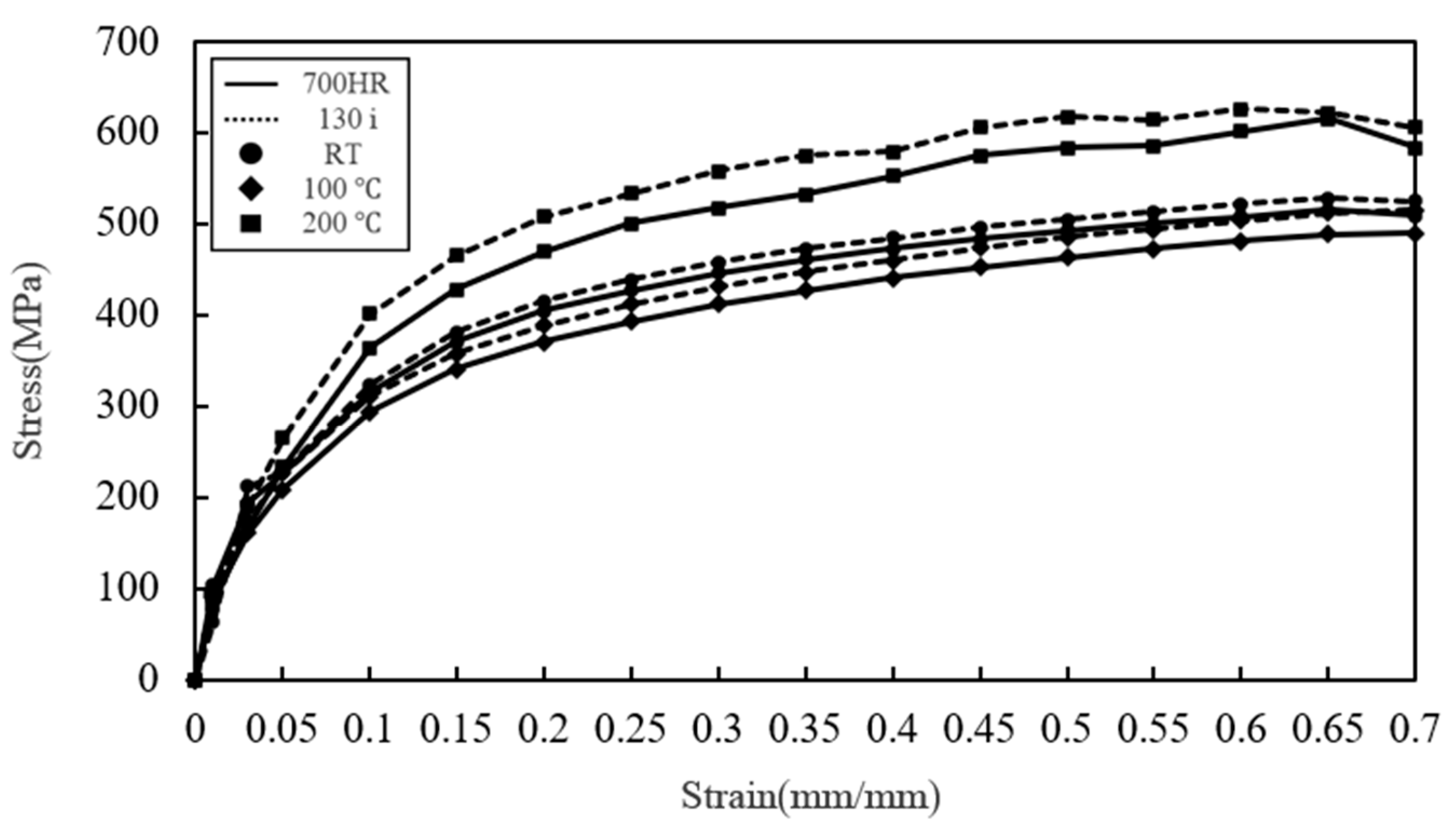
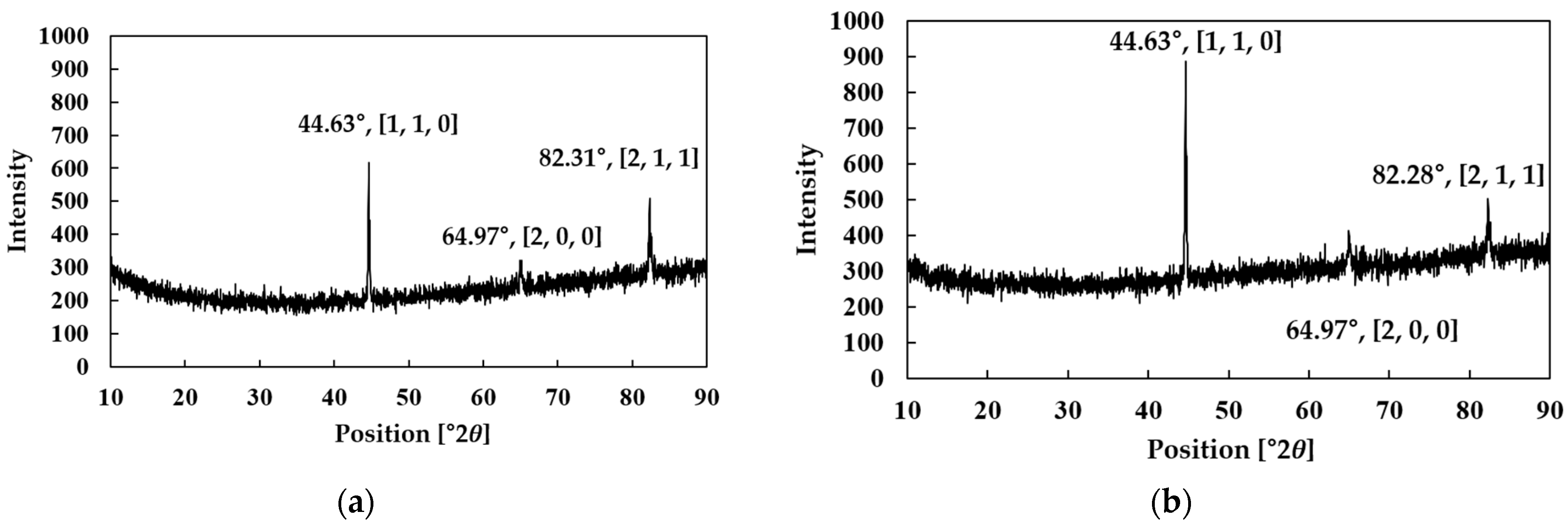


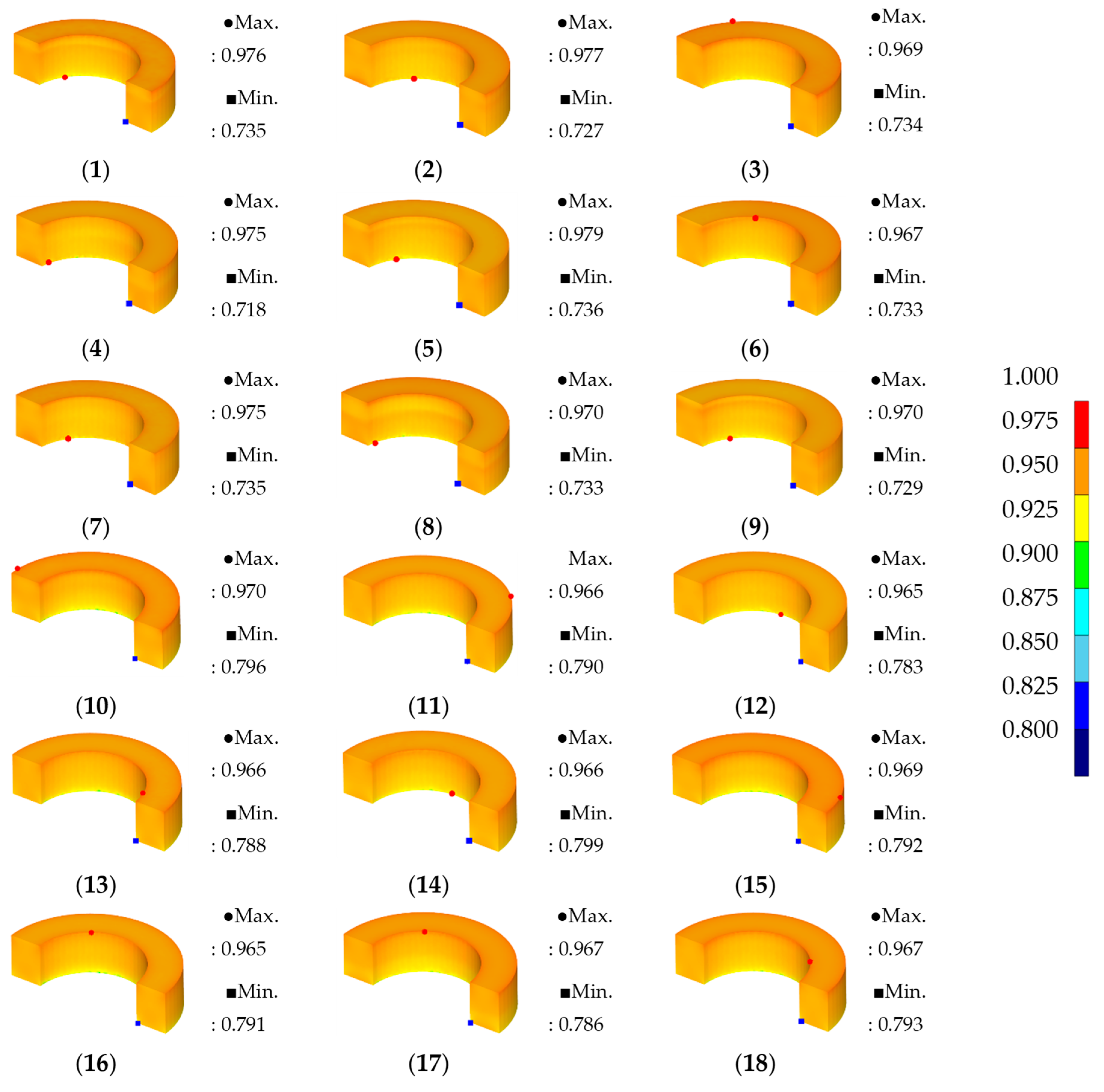
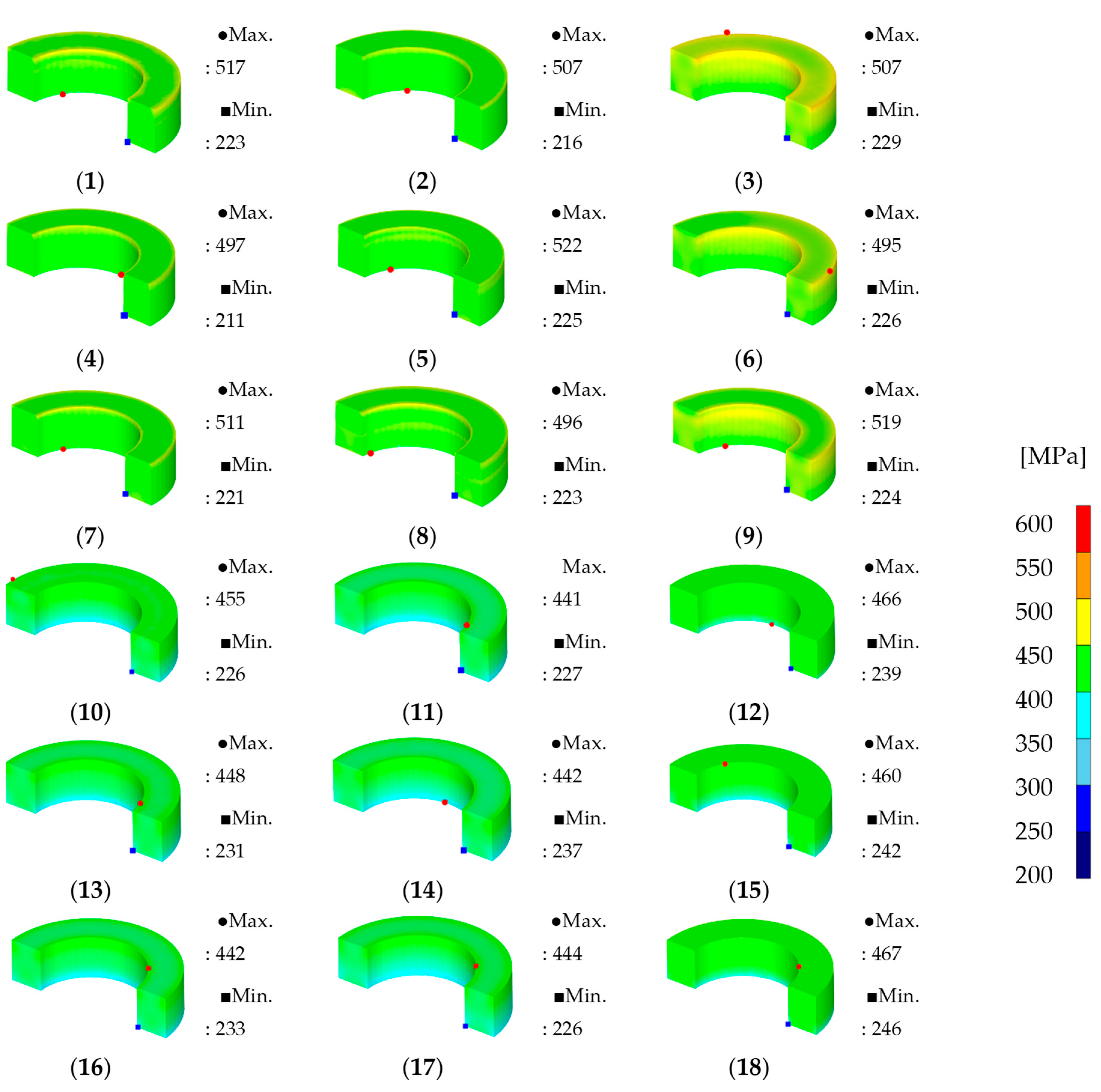
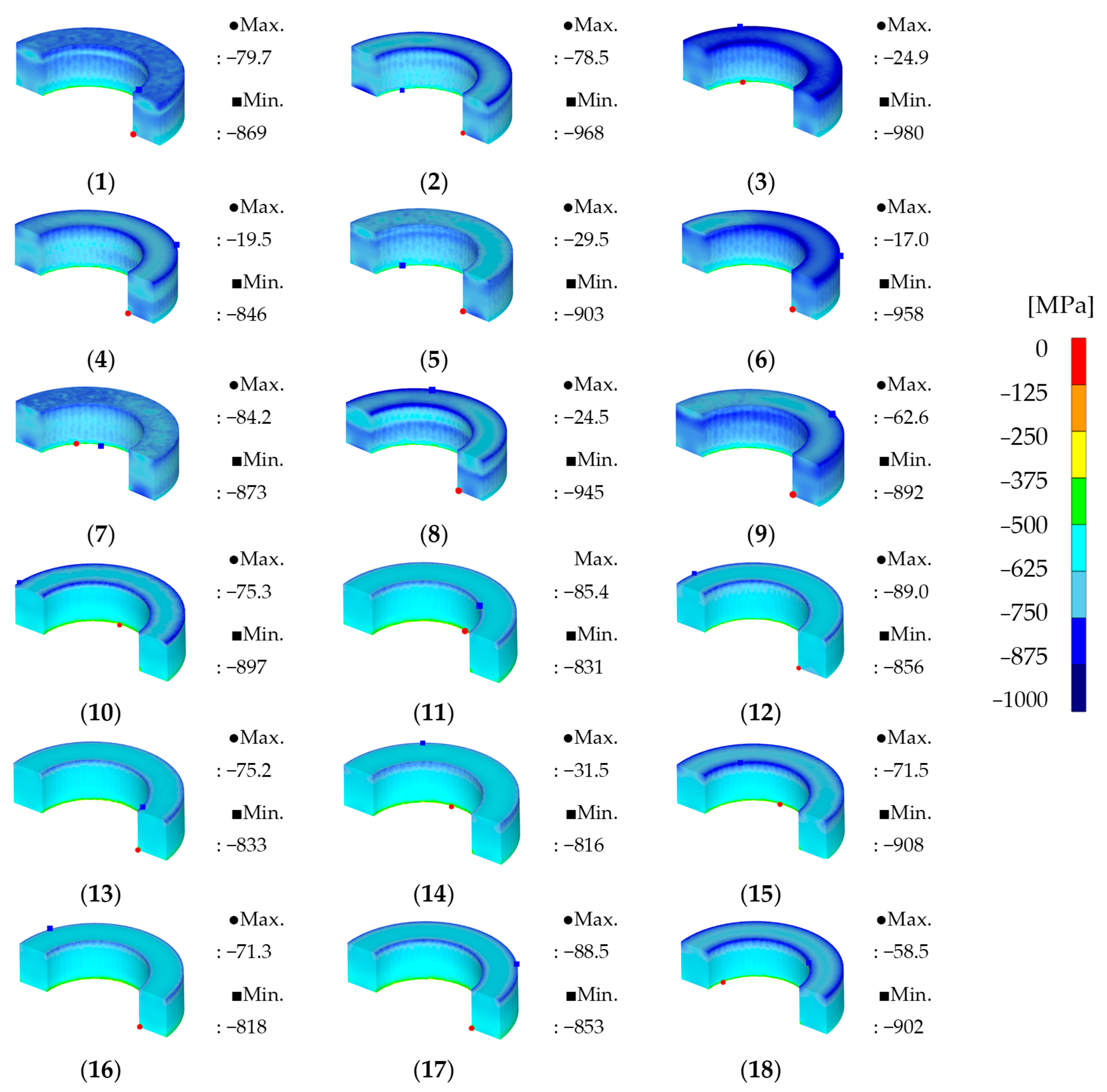

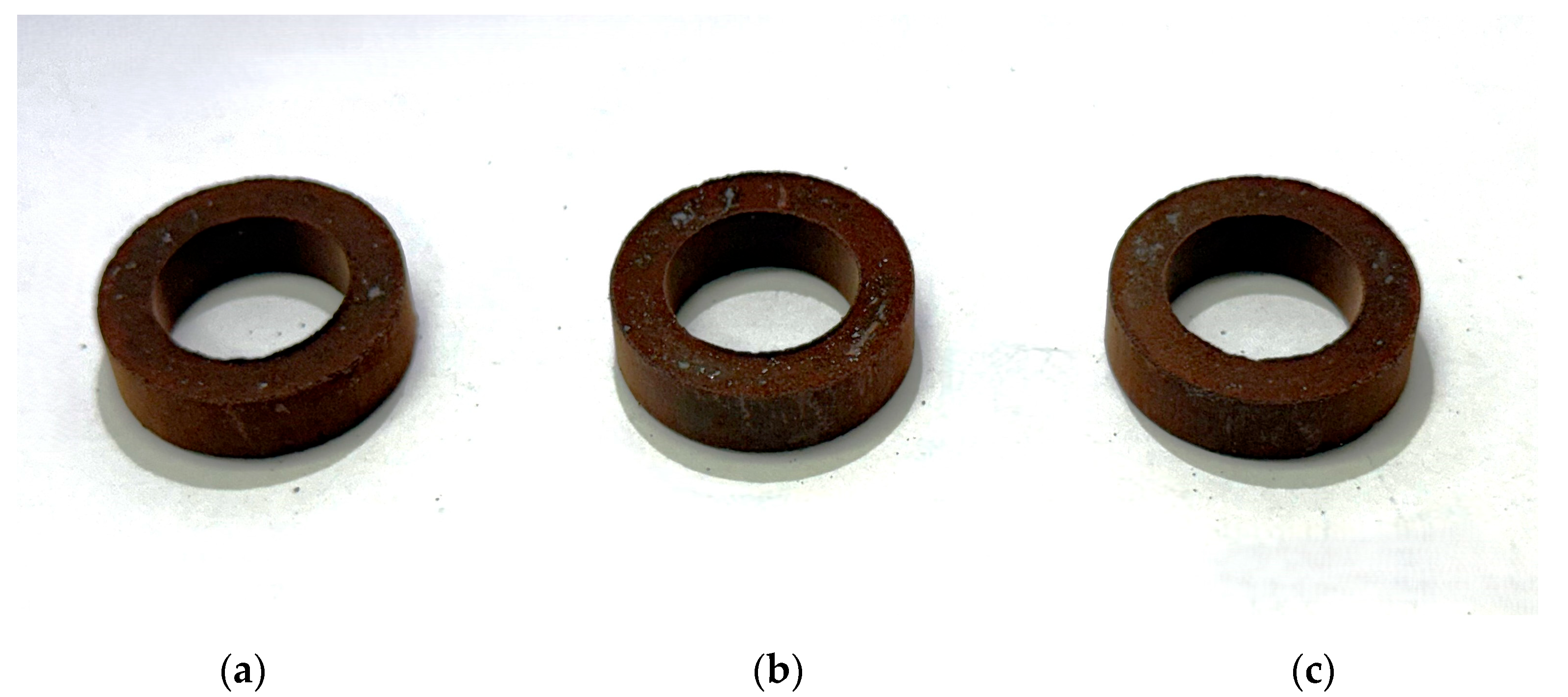
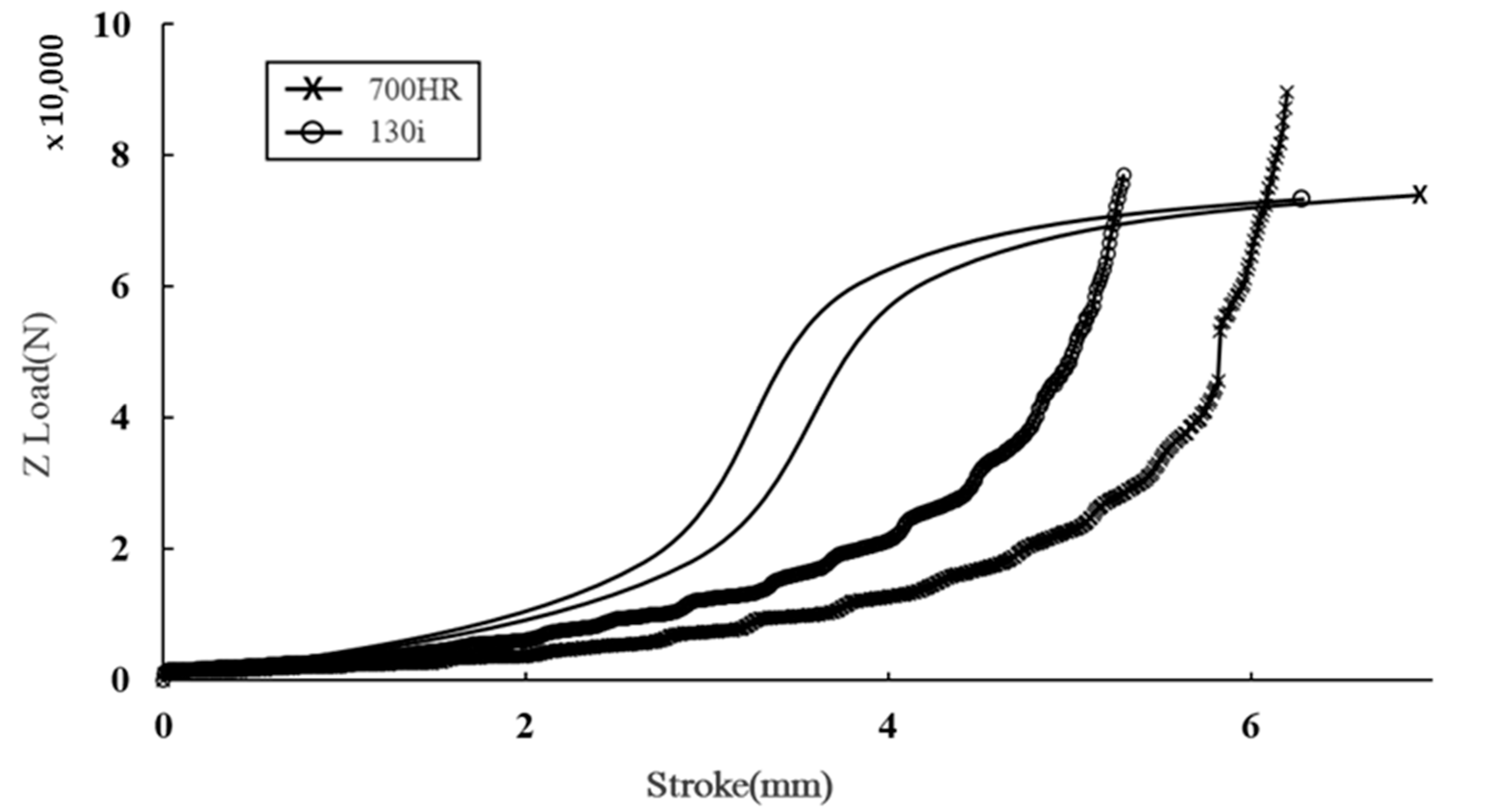




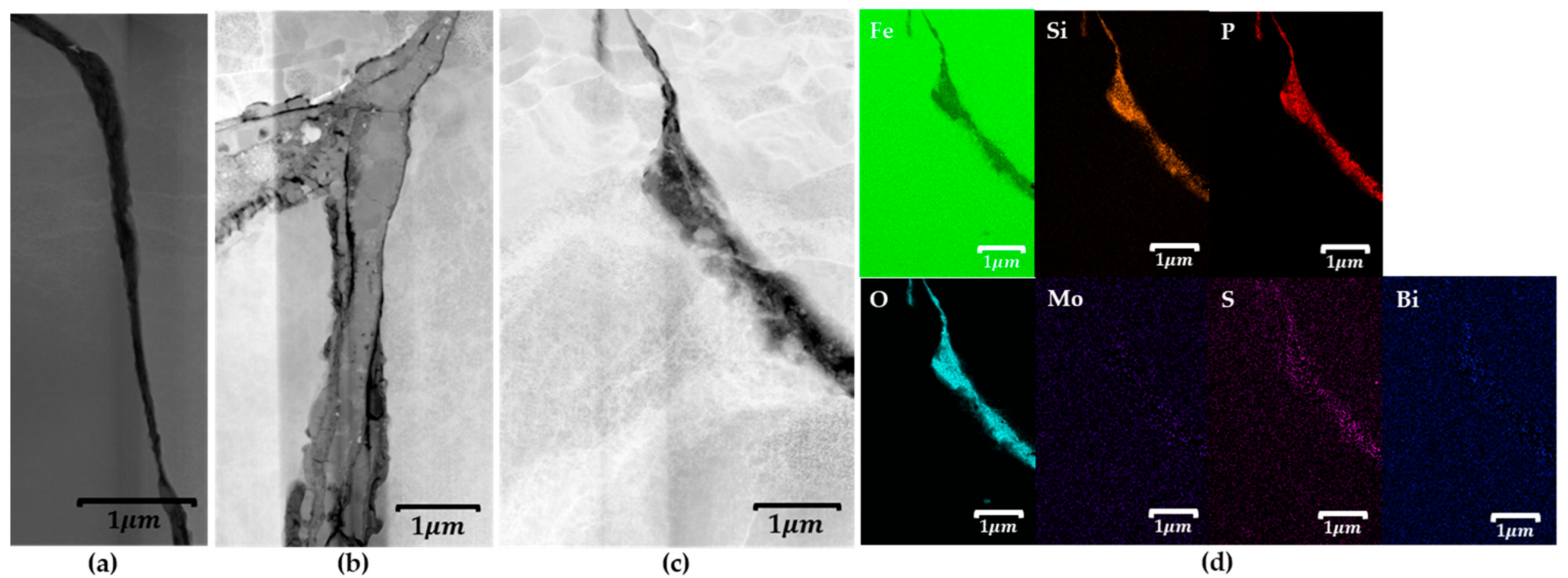


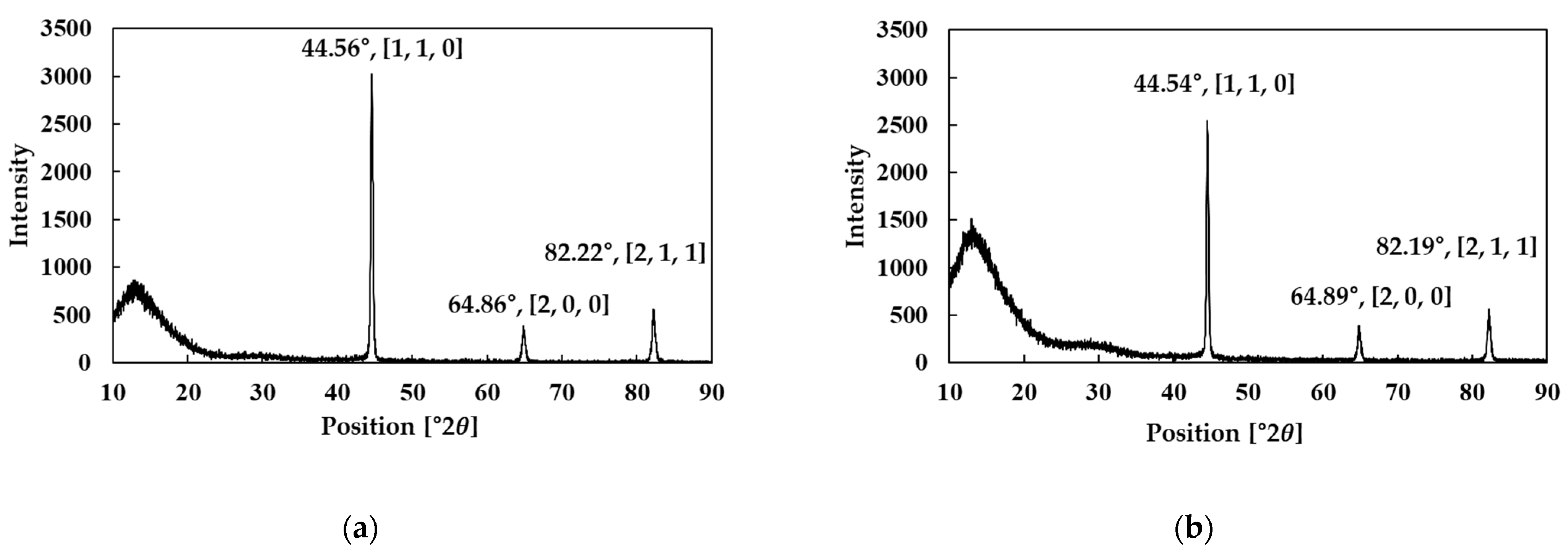
| Factor | 700HR 5P | 130i 5P |
|---|---|---|
| Thermal expansion | 0.000011 | 0.000011 |
| Thermal conductivity | 26 | 26 |
| Factor | Description | Level | ||
|---|---|---|---|---|
| 1 | 2 | 3 | ||
| A | Powder Type | 700HR 5P | 130i 5P | - |
| B | Forming Speed [mm/s] | 2 | 5 | 8 |
| C | Forming Temperature [°C] | 60 | 80 | 100 |
| Simulation No. | A | B | C |
|---|---|---|---|
| 1 | 1 | 1 | 1 |
| 2 | 1 | 2 | 2 |
| 3 | 1 | 3 | 3 |
| 4 | 1 | 1 | 2 |
| 5 | 1 | 2 | 3 |
| 6 | 1 | 3 | 1 |
| 7 | 1 | 1 | 3 |
| 8 | 1 | 2 | 1 |
| 9 | 1 | 3 | 2 |
| 10 | 2 | 1 | 1 |
| 11 | 2 | 2 | 2 |
| 12 | 2 | 3 | 3 |
| 13 | 2 | 1 | 2 |
| 14 | 2 | 2 | 3 |
| 15 | 2 | 3 | 1 |
| 16 | 2 | 1 | 3 |
| 17 | 2 | 2 | 1 |
| 18 | 2 | 3 | 2 |
| No. | Average Relative Density | Max-Min Relative Density | Average Effective Stress [MPa] | Max-Min Effective Stress [MPa] | Average Mean Stress [MPa] | Max-Min Mean Stress [MPa] | Compaction Pressure [MPa] |
|---|---|---|---|---|---|---|---|
| 1 | 0.948 | 0.241 | 454.191 | 294 | −733.793 | 789.3 | 886.4 |
| 2 | 0.948 | 0.250 | 452.507 | 291 | −735.668 | 889.5 | 851.8 |
| 3 | 0.948 | 0.235 | 469.555 | 278 | −764.448 | 995.1 | 921.4 |
| 4 | 0.947 | 0.238 | 451.574 | 268 | −724.896 | 826.5 | 879.4 |
| 5 | 0.947 | 0.243 | 453.001 | 297 | −730.856 | 873.5 | 905.5 |
| 6 | 0.947 | 0.234 | 462.702 | 269 | −730.856 | 873.5 | 891.1 |
| 7 | 0.948 | 0.240 | 451.908 | 290 | −730.468 | 788.0 | 877.3 |
| 8 | 0.948 | 0.235 | 469.555 | 278 | −764.448 | 995.1 | 872.2 |
| 9 | 0.947 | 0.241 | 466.648 | 295 | −752.274 | 829.4 | 877.3 |
| 10 | 0.945 | 0.175 | 407.656 | 216 | −649.772 | 821.7 | 780.8 |
| 11 | 0.945 | 0.176 | 402.984 | 214 | −641.903 | 745.6 | 782.3 |
| 12 | 0.945 | 0.182 | 428.198 | 227 | −679.811 | 770.0 | 826.6 |
| 13 | 0.945 | 0.178 | 405.701 | 217 | −644.882 | 757.8 | 765.9 |
| 14 | 0.946 | 0.167 | 405.239 | 205 | −646.356 | 784.5 | 833.5 |
| 15 | 0.945 | 0.177 | 419.569 | 218 | −668.699 | 836.5 | 785.6 |
| 16 | 0.945 | 0.174 | 404.850 | 209 | −643.860 | 746.7 | 826.8 |
| 17 | 0.945 | 0.181 | 401.339 | 218 | −641.267 | 764.5 | 791.2 |
| 18 | 0.946 | 0.174 | 426.868 | 221 | −682.785 | 843.5 | 786.5 |
| Linear Dimension | Specimen 1 | Specimen 2 | Specimen 3 |
|---|---|---|---|
| Outer Diameter [mm] | 20.39 | 20.41 | 20.33 |
| Inner Diameter [mm] | 12.73 | 12.77 | 12.77 |
| Height [mm] | 5.40 | 5.58 | 5.52 |
| Volume [mm3] | 1075.43 | 1110.39 | 1084.32 |
| Weight [g] | 7.82 | 7.84 | 7.98 |
| Calculated Density [g/cm3] | 7.27 | 7.06 | 7.36 |
| Measured Density [g/cm3] | 7.32 | 7.24 | 7.37 |
| Linear Dimension | Specimen 4 | Specimen 5 | Specimen 6 |
|---|---|---|---|
| Outer Diameter [mm] | 20.39 | 20.34 | 20.39 |
| Inner Diameter [mm] | 12.74 | 12.73 | 12.72 |
| Height [mm] | 5.47 | 5.42 | 5.25 |
| Volume [mm3] | 1100.56 | 1070.75 | 1046.61 |
| Weight [g] | 7.67 | 7.53 | 7.52 |
| Calculated Density [g/cm3] | 6.97 | 7.03 | 7.19 |
| Measured Density [g/cm3] | 7.21 | 7.22 | 7.33 |
| Calculated Density [g/cm3] | Measured Density [g/cm3] | Relative Error (%) | |
|---|---|---|---|
| Somaloy 700HR 5P | 7.23 | 7.31 | 1.12 |
| Calculated Density [g/cm3] | Measured Density [g/cm3] | Relative Error (%) | |
|---|---|---|---|
| Somaloy 130i 5P | 7.06 | 7.26 | 2.76 |
| 700HR 5P | AVG [nm] | SD [nm] | Min [nm] | Max [nm] | Max-Min [nm] | CV [%] |
|---|---|---|---|---|---|---|
| (a) | 301.3 | 96.0 | 140 | 340 | 200 | 31.9 |
| (b) | 816.4 | 52.2 | 719 | 868 | 149 | 6.4 |
| (c) | 901.1 | 351.9 | 408 | 1490 | 1082 | 39.0 |
| 130i 5P | AVG [nm] | SD [nm] | Min [nm] | Max [nm] | Max-Min [nm] | CV [%] |
|---|---|---|---|---|---|---|
| (a) | 140.0 | 58.9 | 60 | 200 | 140 | 42.1 |
| (b) | 712.7 | 272.0 | 239 | 1060 | 821 | 38.2 |
| (c) | 475.9 | 302.6 | 68 | 772 | 704 | 63.6 |
| 50 Hz | 200 Hz | 400 Hz | 800 Hz | |
|---|---|---|---|---|
| 0.5 T | 0.99 | 4.2 | 9.09 | 20.9 |
| 1.0 T | 3.34 | 14.36 | 31.44 | 73.76 |
| 1.5 T | 6.8 | 29.49 | 65.1 | 154.68 |
| 50 Hz | 200 Hz | 400 Hz | 800 Hz | |
|---|---|---|---|---|
| 0.5 T | 1.22 | 5.02 | 10.44 | 22.48 |
| 1.0 T | 4.1 | 17 | 35.61 | 77.65 |
| 1.5 T | 8.35 | 34.74 | 73.1 | 160.65 |
Disclaimer/Publisher’s Note: The statements, opinions and data contained in all publications are solely those of the individual author(s) and contributor(s) and not of MDPI and/or the editor(s). MDPI and/or the editor(s) disclaim responsibility for any injury to people or property resulting from any ideas, methods, instructions or products referred to in the content. |
© 2025 by the authors. Licensee MDPI, Basel, Switzerland. This article is an open access article distributed under the terms and conditions of the Creative Commons Attribution (CC BY) license (https://creativecommons.org/licenses/by/4.0/).
Share and Cite
Sim, M.; Lee, S. A Study on the Influence of the Properties of Commercial Soft Magnetic Composite Somaloy Materials on the Compaction Process. Appl. Mech. 2025, 6, 65. https://doi.org/10.3390/applmech6030065
Sim M, Lee S. A Study on the Influence of the Properties of Commercial Soft Magnetic Composite Somaloy Materials on the Compaction Process. Applied Mechanics. 2025; 6(3):65. https://doi.org/10.3390/applmech6030065
Chicago/Turabian StyleSim, Minseop, and Seonbong Lee. 2025. "A Study on the Influence of the Properties of Commercial Soft Magnetic Composite Somaloy Materials on the Compaction Process" Applied Mechanics 6, no. 3: 65. https://doi.org/10.3390/applmech6030065
APA StyleSim, M., & Lee, S. (2025). A Study on the Influence of the Properties of Commercial Soft Magnetic Composite Somaloy Materials on the Compaction Process. Applied Mechanics, 6(3), 65. https://doi.org/10.3390/applmech6030065






